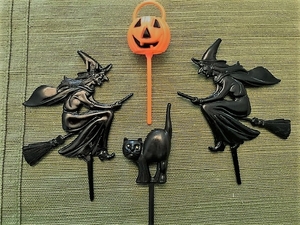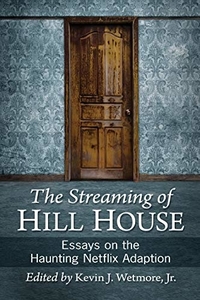Halloween Haunts: From Birthdays to Doorbells to Arson: Mischief Night
By Kevin Wetmore
My mother’s birthday is October 30. She told us that when she was growing up her parents would throw a Halloween-themed birthday party. My grandmother would call my mother’s friend Bunny’s father, who ran a bakery, to make a Jack-o-lantern cake decorated with plastic witches on broomsticks holding the candles and all sorts of Halloween themed plastic paraphernalia. (To me that sounds like Heaven). As a result, however, my mother does not much care for Halloween, as it required her to share her birthday with a national holiday aimed (at the time) at children and she felt her parents turned what should be her special day into a holiday party for her friends and  family. (Tangentially, what made her unhappy would have thrilled me, and I was delighted when a few years back, when my parents moved, she gifted me with a treasure trove of those Halloween cake decorations from the forties and fifties. My family and I use them still.)
family. (Tangentially, what made her unhappy would have thrilled me, and I was delighted when a few years back, when my parents moved, she gifted me with a treasure trove of those Halloween cake decorations from the forties and fifties. My family and I use them still.)
October 30, however, is not merely the night before Halloween. It is known by a number of names. My mother called it “Doorbell Night” and she and Bunny participated in the time-honored tradition on Edwards Street in New Haven of ringing the neighbors’ doorbells and running. She and her friends realized the trouble they would get in if caught, but it was tradition.
 By the time she had children, however, my mother’s birthday had grown darker in the United States. As I was growing up in the seventies and eighties, the 30th was known as “Devil’s Night” or “Mischief Night.” When I was in elementary school our family realized that we could no longer go out on the 30th to celebrate my mother’s birthday. We would come home from a birthday dinner out to find soap on our windows, toilet paper in our trees, eggs thrown against the side of the house, pumpkins smashed, and other messes caused by neighborhood kids (ostensibly otherwise our friends!) who knew we would not be home that night.
By the time she had children, however, my mother’s birthday had grown darker in the United States. As I was growing up in the seventies and eighties, the 30th was known as “Devil’s Night” or “Mischief Night.” When I was in elementary school our family realized that we could no longer go out on the 30th to celebrate my mother’s birthday. We would come home from a birthday dinner out to find soap on our windows, toilet paper in our trees, eggs thrown against the side of the house, pumpkins smashed, and other messes caused by neighborhood kids (ostensibly otherwise our friends!) who knew we would not be home that night.
Historically, the night had several names: Goosy Night, Cabbage Night, Miggy Night, Gate Night, and Devil’s Eve. If the night before All Saint’s Day was All Hallow’s Eve, then the night before that belonged to the devil. In the United States, the “holiday” began as a night of pranks, much as Halloween did (see Lisa Morton’s Trick or Treat & The Halloween Encyclopedia for the history of that holiday and its modern origins in 19th and 20th century pranking, among other things). There had been other pranking holidays, most notably May 1 (May Day) and November 4 (Guy Fawkes’ Eve), but during the Great Depression the attempt to separate Halloween from pranking seems to have just moved it up a day. A 1937 article in the Daily Boston Globe describes teens and children as “ringing false alarms, setting fires, breaking windows, and in general doing their best to annoy people” on October 30. Indeed, it was “setting fires” that was synonymous with Devil’s Night at the time our family stopped going out for my mother’s birthday (Although we lived in Connecticut, not Michigan, the local media ensured a steady diet of panic over Devil’s Night across the nation and seemingly tried to convince us that it was possible local arsonists might get ideas if we were not vigilant. The more things change…)
In 1983, Devil’s Night as a night of setting fires began in Detroit, and by the following year 297 fires were started in a single night, and over 800 in the days from October 29 to November 2. A curfew for anyone under 18 was imposed by the city of Detroit in 1986 but did little to mitigate the arson. By 1990 The New York Times was reporting the efforts to “Quell Fires of Devil’s Night” as the headline proclaimed on October 30. According to the article, 35,000 city employees, members of community organizations, and block clubs were enlisted to participate in neighborhood patrols, fighting the fires of Devil’s Night. The number of fires slowly but significantly went down in the latter half of the eighties and through the nineties, and by 2017 there were only twenty-one fires on Devil’s Night in the entire city and only five in 2018.
Unlike Halloween, Mischief Night is not uniformly practiced across the United States. As with the variety of names, there are a variety of practices associated with it depending on where in the country one is growing up. Indeed the names reflect that reality: parts of New England refer to it as “Cabbage Night” due to the historic practice of throwing and smearing rotten vegetables on this night; whereas it is known as “Gate Night” in parts of the Midwest since the dominant prank was to open livestock gates so that the poor farmers would have to spend the night and morning finding and gathering their animals. The holiday is called “Mat Night” in Quebec, as the traditional practice is to steal and swap doormats.
I must admit, Devil’s Night has been quiet for much of my life since those toilet paperings our family endured in the seventies, and I kind of miss it. There was a thrill to hearing your doorbell ring, opening it, and no one was there. It’s that same frission of fun that Halloween, a prank-laden holiday, also gives when you are a child. The possibility that behind the mask (or the prank), there lurked something spooky, scary, supernatural or from beyond the veil, instead of just that punk kid next door. If I am honest, I’m kind of hoping my doorbell rings today. (Although, given that we’re still in the middle of a pandemic, I’m not sure I would answer, and besides, Ring ™ kind of makes Doorbell Night impossible).
Still, as part of the whole childhood Halloween experience, I treasure Mischief Night. And I am also delighted that even if she didn’t care for the connection to Halloween, that my favorite holiday also reminds me of my mother. So happy birthday, Mom. And Happy Halloween. I hope tonight is as boring as tomorrow is exciting for both of us. And I hope, maybe just this once, even in your seventies, you’ll be tempted to ding dong and dash at dusk. You know your neighbors take forever to answer the door and you and Bunny might just get away with it one last time for old time’s sake.
Kevin is giving away a free signed copy of his edited collection The Streaming of Hill House: Essays on the Haunting Netflix Series (McFarland, 2020). To be entered into the drawing for the book, send an email to HalloweenHaunts2020@gmail.com or enter in the comments below.
Netflix Series (McFarland, 2020). To be entered into the drawing for the book, send an email to HalloweenHaunts2020@gmail.com or enter in the comments below.

Kevin Wetmore is the Bram Stoker Award-nominated editor of Uncovering Stranger Things and The Streaming of Hill House. He is also the author of Post-9/11 Horror in American Cinema and Back from the Dead: Reading Remakes of Romero’s Horror Films as Markers of their Times, as well as the forthcoming Eaters of the Dead from Reaktion Books and the Devil’s Advocates volume on The Conjuring for Auteur (available April 2021). He is also a prolific short story writer with his work featured or forthcoming in numerous anthologies and magazines such as Midian Unmade, Weirdbook, Mothership Zeta, Enter at Your Own Risk: The End is the Beginning, Whispers from the Abyss 2, and Cemetery Dance. He was co-chair of StokerCon 2017 and 2018 and is the volunteer coordinator for Stokercon 2019 and 2021, as well as the Coordinator/Curator for this year’s Halloween Haunts blog. You can learn more about his work at www.SomethingWetmoreThisWayComes.com



